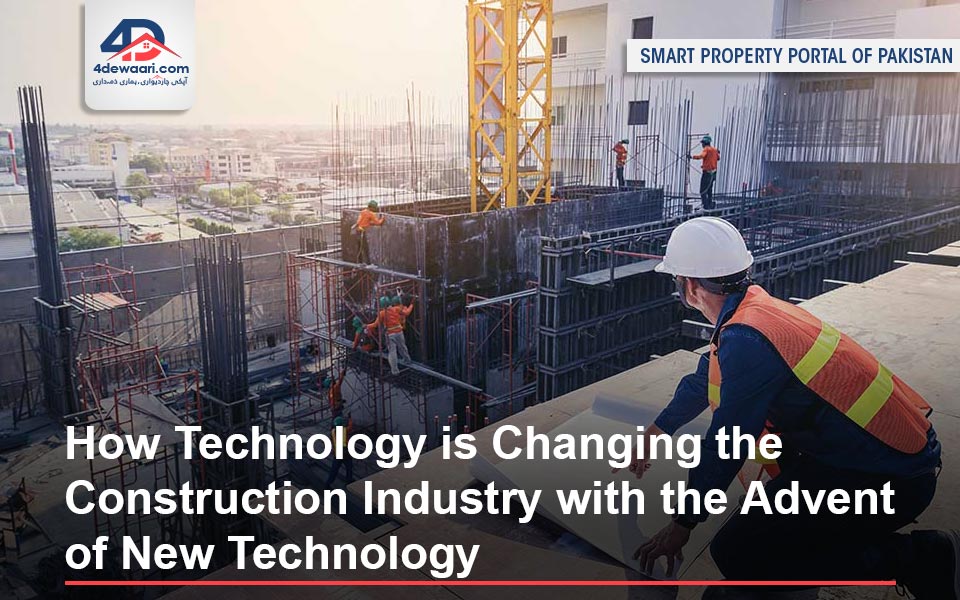Construction is one of the oldest industries in the world economy. New technology has been transforming the construction industry in recent years, and even those people who aren’t directly involved in the industry have likely heard about the rise of 3D printing, drones, and similar innovations that have brought new processes to construction firms worldwide. From our homes to office buildings to roads and bridges, technology has completely transformed the construction industry in recent years and some huge benefits go along with it. This article will discuss How Technology is Changing the Construction Industry ?. We'll also discuss several key building innovations that today's builders and architects use. Thus, when creating your homes or offices, you will have a better idea of how to keep up with current building trends.
How Technology is Changing the Construction Industry?
Construction has traditionally been a field that relies on physical labor. As the industry evolves, it's finding ways to streamline processes and make its workers more efficient. Construction firms are constantly looking for methods to boost productivity and cut expenses. Increasing the use of technology is the way they are achieving this. The hope is that by using smart technology, there will be less need for human interaction and oversight in tasks like surveying or managing building sites. Take a look at how the construction sector is being affected by current technology.
Read Also
Problems and Challenges in Real Estate
Impact Of Technology On The Construction Industry
From time-saving technologies like robotics and drones to new methods of prefabrication, there are plenty of technological advances that have changed how things get done in this industry. For example, instead of printing out blueprints, many companies now make use of computer-aided design software to create them from scratch. The benefit of this approach is that it eliminates a step in the process that could lead to mistakes or confusion. It also saves time because there is no need to order paper or ink cartridges and employees wait for blueprints to be delivered before work can commence. Furthermore, Computer-aided manufacturing software, meanwhile, enables workers to cut steel and other materials quickly and precisely without risking injury by using manual tools. Even project management software has made its mark on the industry by facilitating easy collaboration between team members across long distances.
Additionally, drones offer aerial views that help ensure quality control from start to finish. The use of robotics in particular has increased significantly in recent years as they can increase efficiency and reduce cost on a wide range of projects.
As a result of these innovations, today’s construction company operates very differently than its counterparts did 20 years ago.
Types Of New Technology Used In The Construction Sector
The following technologies are being used by builders and architects in their construction projects:
• Augmented reality
• Virtual reality
• 3D printing
• Construction Industry Software
• Drones
• Prefabricated modules
• Building Information Modeling
• Data collection apps
How does 3d printing affect architecture?
In the last few years, 3D printing technology has been introduced to the architecture world and it is quickly becoming a staple in architectural design. This new technology allows architects to create their designs without having to go through a lengthy and expensive process.
Designers can now use 3D printers to construct models for clients in minutes instead of days or weeks. The printer deposits layers of material that build up into a solid object layer by layer until the desired shape is achieved.
Read Also
Why You Should Invest in Real Estate
Construction Projects Using Drone Technology
Drones are an emerging technology that is changing the way construction projects can be executed. For example, drones could be used to inspect and take photos of a bridge before it is built, or they could help calculate the amount of concrete needed for a project.
In addition, drones provide clear aerial footage of the site which helps contractors assess work done by their teams more easily.
However, there are some disadvantages of drone use in the construction industry. It includes:
• High start-up cost
• Regulations preventing drone usage on certain sites
• Lack of understanding among workers about how to use them
• Increased need for post-processing with data collected by drones
The Use Of Bim (Building Information Modeling)
BIM is a way for an organization or individual to represent and store the complete history, current status, and future potential of a building. BIM can be seen as the unification of all design, engineering, and management information related to a building project. The best part about BIM is that it enables many disciplines to work together during the design process, thereby reducing errors and improving efficiency.
Furthermore, BIM allows engineers to simulate the effects of a change before implementing them on site. BIM includes 3D models of everything from structural supports and plumbing systems to furniture layouts. It also includes elements such as materials specifications, energy use, waste disposal locations, and occupant needs. All these components combined enable architects to assess whether their designs will work from start to finish. One downside to BIM is that it has yet to reach widespread adoption within the industry. It is mostly because many people find it challenging to comprehend how BIM functions in detail.
Using Ar To Share Data On Construction Sites
One technology that's been on the rise is “Augmented Reality or AR”. As a way to make data gathering more efficient and accurate, AR provides a digital overlay to the physical space. That means you can use your phone or tablet as a window into what's happening at the construction site. You can see everything from where pipes are running underground to where cables need to be placed. Construction companies can save time with this because they don't have to walk around a job site, trying to figure out which parts of the property have not yet been mapped. They also save money because they don't have to hire outside contractors for surveying projects anymore. By 2024, the international AR market is anticipated to be worth $300 billion. AR will significantly improve how humans and digital technology collaborate on the job, as opposed to displacing workers on the ground.
Role Of Drone Technology In Construction
Another important tool in this industry is drones. They're often used for aerial surveys of large building sites, but they have many other uses too.
Builders can use drones with water tanks or fire-fighting equipment up high where humans couldn't otherwise reach them without special equipment.
Usage Of Data Collection Apps In Construction
Construction managers and owners need a way to track their projects, keep up with deadlines, and ensure that they have the right materials on hand. One great way to do this is with a data collection app. Apps for data collection assist in ensuring you have quick access to the data you require. Apps like Estimator allow you to create estimates for your projects and can sync up with QuickBooks so that your project costing and budgeting work together seamlessly.
Final Thoughts
Technology has been a boon for the construction industry. As you can see how the construction industry is altering quickly with the advent of new technology. Advancements in design software, 3D printing, and advanced robotics have helped build better structures faster than ever before.
There are still difficulties to be resolved. But there's no denying that it will alter how structures are constructed in the future.















